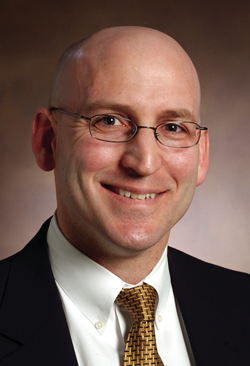
Michael Higgins
Anesthesiology’s IT efforts land honor from Microsoft
Vanderbilt's Department of Anesthesiology is among this year's winners of the Healthcare Innovation Award from the Microsoft Healthcare Users Group.
The department won the 2008 award for “Best Use of Clinical Records — Inpatient.”
Winners were announced at the recent Healthcare Information and Management Systems Society annual conference in Orlando, Fla.
“This is a sign of the health care industry taking increasing notice of the innovative information technology solutions developed at Vanderbilt,” said Steven Gabbe, M.D., dean of the School of Medicine. “Congratulations to Dr. Higgins and his team for this well-deserved recognition.”
Michael Higgins, M.D., M.P.H., professor and chair of the department, has led Anesthesiology's clinical informatics efforts since joining the faculty as an assistant professor in 1994.
In connection with the award, Higgins singled out the contributions of Paul St. Jacques, M.D., associate professor of Anesthesiology and Biomedical Informatics, and Nimesh Patel, director of Perioperative Informatics and Computing Services.
“It's wonderful to be recognized by a large and prestigious organization like Microsoft Healthcare Users Group, with almost 5,000 members involved in healthcare IT. It's a great endorsement of the work done by the team here at Vanderbilt,” Higgins said.
The award was for two connected pieces of technology — Vigilance and VPIMS (Vanderbilt Perioperative Information Management System).
VPIMS supports medical documentation and detailed OR patient tracking. It produces data useful for improving care and for analyzing OR efficiency, and it affords up-to-the-minute views of what's happening across the OR.
Vigilance is a wireless network application for remote monitoring of OR patients, integrating information from the anesthesia machine, heart monitor and the VPIMS patient record, as well as views from operating room video cameras.
Vigilance runs on workstations or on a small wireless computer used by the anesthesiologist.
VPIMS and Vigilance were recently licensed for commercial development to Acuitech, based in Birmingham, Ala. The Department of Anesthesiology will collaborate in the further development of the commercial version. (Acuitech was named a co-winner of the recent award.)
Two studies of VPIMS and Vigilance are under way at Vanderbilt, supported by a $1.2 million grant from the U.S. Department of Defense.
One study is looking at the effect of Vigilance on the situational awareness of anesthesiologists in the OR, to learn whether such technology could improve the safety of surgical care.
A second study, on Round Wing postoperative floors, is examining whether wireless patient monitoring can help reduce mortality in postoperative care settings by aiding earlier detection of patient problems.
“Our goal at Vanderbilt is to be the safest hospital in America, and one way to help us do that is to leverage our advanced information technology systems and tools,” Higgins said.













